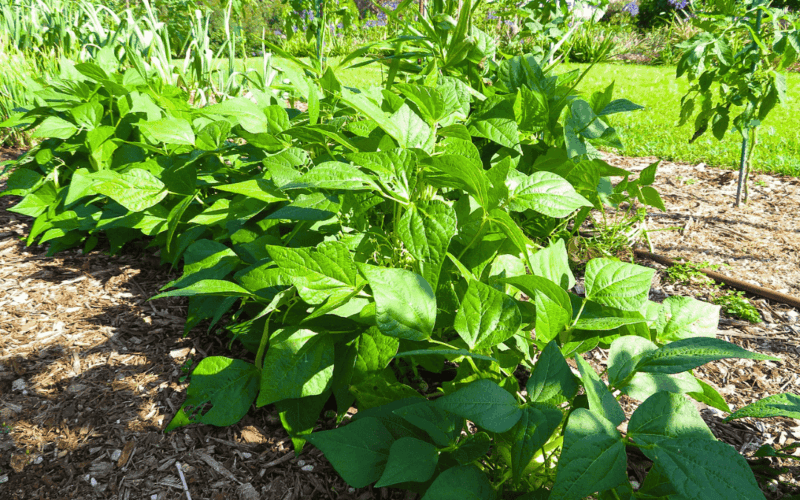Most gardeners plant beans in isolation, missing out on nature’s most effective partnership system.
Bean plants themselves enhance soil nutrition, benefiting its partners in return, creating a win-win relationship that can dramatically increase garden productivity.
In this guide, you’ll discover the 12 most effective companion plants that work symbiotically with beans to boost growth, repel harmful pests, and maximize your harvest naturally.
Whether you’re growing bush beans or pole varieties, these scientifically-backed companion plantings will transform your bean patch into a thriving ecosystem that requires fewer pesticides and produces healthier crops.
Corn: The Classic Three Sisters Foundation
Pole beans, corn, and winter squash are sometimes called the “Three Sisters” and they are one of the oldest companion plant pairings around. This time-tested combination offers multiple benefits that make corn an exceptional companion for beans.
The tall corn stalks provide natural support for climbing bean varieties, eliminating the need for additional trellising. Meanwhile, the beans attract beneficial insects that prey on corn pests, such as leaf beetles, fall armyworms, and leafhoppers. The bean’s nitrogen-fixing ability also enriches the soil, providing essential nutrients that corn requires for healthy growth.
Pro Tip: Plant corn 2-3 weeks before beans to ensure the stalks are sturdy enough to support the climbing vines.
Cucumber: Mutual Protection Partnership
Cucumbers and beans create one of gardening’s most beneficial partnerships. Cucumbers, cabbage, chard, lettuce, celery, spinach and tomatoes are also good companions for beans, but cucumbers offer unique advantages through their growth habits and pest-deterring properties.
The sprawling cucumber vines help suppress weeds around bean plants, while the beans provide nitrogen that cucumbers need for vigorous growth. Both plants benefit from similar watering schedules and soil conditions, making garden management more efficient.
This partnership works particularly well in raised bed gardening systems where space optimization is crucial.
Radishes: Fast-Growing Soil Improvers
Radishes serve as excellent companion plants for beans due to their rapid growth cycle and soil-improving properties. These quick-maturing vegetables break up compacted soil with their taproots, creating better drainage and aeration for bean root systems.
The fast harvest cycle of radishes allows gardeners to maximize space efficiency. By the time beans need full growing room, radishes have already been harvested, leaving behind improved soil structure and nutrients.
Key Takeaway: Plant radishes between bean rows for maximum soil improvement without competition issues.
Carrots: Deep Root Synergy
Carrots and beans complement each other perfectly through their different root systems and growth patterns. While beans have relatively shallow roots, carrots develop deep taproots that don’t compete for the same soil nutrients and water.
The deep carrot roots help break up heavy clay soils, improving drainage for the entire garden bed. Additionally, the feathery carrot foliage provides ground cover that helps retain soil moisture around bean plants.
This partnership is particularly effective in companion vegetable gardens where maximizing growing space is essential.
Celery: Pest-Deterring Aromatics
Celery’s strong aromatic compounds make it an excellent natural pest deterrent for bean plants. The distinctive scent helps mask the bean plants from harmful insects while attracting beneficial predators that control garden pests.
Companion plants for beans include savory, strawberries, cucumbers, cabbage, kohlrabi, beet, lettuce, celery, tomatoes, potatoes, lettuce and leaf lettuce. Celery’s inclusion in this list reflects its proven effectiveness as a bean companion.
The celery’s upright growth habit also provides wind protection for young bean plants without creating excessive shade.
Spinach: Cool-Season Compatibility
Spinach thrives in the partial shade created by bean plants, making it an ideal companion for maximizing garden productivity. This leafy green prefers cooler growing conditions, which the bean canopy naturally provides during hot summer months.
The combination works especially well in spring and fall plantings when both crops appreciate similar growing conditions. Spinach’s shallow root system doesn’t compete with beans for nutrients, while its quick growth cycle allows for multiple harvests throughout the growing season.
| Plant Pairing | Growth Benefit | Pest Control | Harvest Timing |
|---|---|---|---|
| Beans + Spinach | Nitrogen fixing for spinach | Natural shade protection | Continuous harvest |
| Beans + Carrots | Deep root aeration | Minimal pest overlap | Staggered harvest |
| Beans + Corn | Structural support | Beneficial insect attraction | Late season harvest |
Lettuce: Efficient Space Utilization
Lettuce varieties work exceptionally well with beans because they occupy different growing niches within the same garden space. The lettuce grows low and spread horizontally, while beans grow vertically, creating efficient use of available sunlight and soil.
This pairing is particularly beneficial in small space gardening where every square foot counts. The beans provide necessary nitrogen for healthy lettuce growth, while the lettuce acts as a living mulch that suppresses weeds and retains soil moisture.
Common Mistake: Avoid planting lettuce too close to vigorous bean varieties that might shade them excessively.
Chard: Colorful Productivity Booster
Swiss chard brings both functionality and beauty to bean companion plantings. If beans, tomatoes, and flowers are together in one bed, the beans will give the tomatoes and flowers a nitrogen boost, the flowers will attract pollinators, and the tomatoes will provide shade to the beans and flowers.
The colorful chard stems add visual interest while providing practical benefits. Chard’s large leaves help suppress weeds around bean plants, and its deep roots access nutrients from lower soil layers, making them available to the shallower bean roots.
This combination thrives in both spring and fall plantings, extending the productive season for both crops.
Savory: Aromatic Pest Protection
Summer savory stands out as one of the most effective herb companions for beans. Summer savory repels bean beetles and improves the flavor and overall growth of bean plants. This dual benefit makes savory an essential addition to any bean garden.
The herb’s compact growth habit allows it to fit easily between bean rows without competing for space. Its strong aromatic oils create a natural barrier against many common bean pests, including aphids and bean beetles.
Many gardeners report that beans grown near savory have improved flavor and tend to produce more pods per plant.
Marjoram: Gentle Pest Deterrent
Marjoram offers subtle but effective pest protection for bean plants through its mild aromatic properties. Unlike stronger herbs that might overwhelm sensitive bean varieties, marjoram provides gentle pest deterrence while attracting beneficial pollinators.
The herb’s small white flowers bloom throughout the growing season, providing nectar for beneficial insects that help control garden pests naturally. This creates a sustainable pest management system that reduces the need for chemical interventions.
Marigolds: Powerhouse Pest Fighters
Marigolds are a recommended companion for many different edible plants, and beans are no exception. These bright flowers produce compounds that naturally repel nematodes, aphids, and other harmful insects that commonly attack bean plants.
The strong scent of marigolds helps mask the bean plants from pest insects while attracting beneficial predators. Additionally, marigolds continue blooming throughout the growing season, providing consistent pest protection and garden beauty.
Pro Tip: Plant marigolds around the perimeter of bean beds for maximum pest protection without interfering with bean growth.
Nasturtiums: Trap Crop Champions
Nasturtium and rosemary both deter bean beetle pests, making nasturtiums particularly valuable as companion plants. These colorful flowers serve as effective trap crops, attracting harmful insects away from bean plants.
The nasturtium’s trailing growth habit makes it perfect for planting at the edges of bean beds. The edible flowers also provide a bonus harvest for gardeners who enjoy adding colorful, peppery blooms to salads and other dishes.
This companion planting strategy represents the latest trend in eco-friendly pest control that’s gaining popularity among sustainable gardeners.
Calendula: Multi-Functional Garden Helper
Calendula rounds out the list of excellent bean companions with its impressive multi-functional benefits. These bright orange and yellow flowers attract beneficial insects while providing natural pest control through their aromatic compounds.
The flowers bloom continuously throughout the growing season, ensuring consistent attraction of pollinators and beneficial predators. Calendula also has the added benefit of being completely edible, with flowers that can be harvested for culinary and medicinal uses.
The plant’s compact growth habit allows it to fit easily into bean garden designs without competing for space or nutrients.
Maximizing Your Bean Companion Garden
Successfully implementing these companion planting strategies requires understanding the timing and spacing requirements for each plant combination. Incorporate companion planting with other pest management techniques, such as hand eradication, row coverings, and crop rotation for optimal results.
Key planting guidelines:
- Start with soil preparation using compost or aged manure
- Plant taller companions (corn) first, followed by beans, then ground covers
- Maintain proper spacing to prevent overcrowding
- Monitor for pest issues and adjust plantings as needed
The science behind companion planting continues to evolve, with trends in lawn care, pest control, and gardening for 2025 reflect a collective move toward sustainability, innovation, and harmony with nature. By implementing these 12 companion plants with your beans, you’ll create a thriving ecosystem that produces healthier crops while reducing the need for chemical interventions.
These natural partnerships represent thousands of years of agricultural wisdom combined with modern scientific understanding, offering gardeners reliable methods for improving both plant health and harvest yields through nature’s own design principles.








